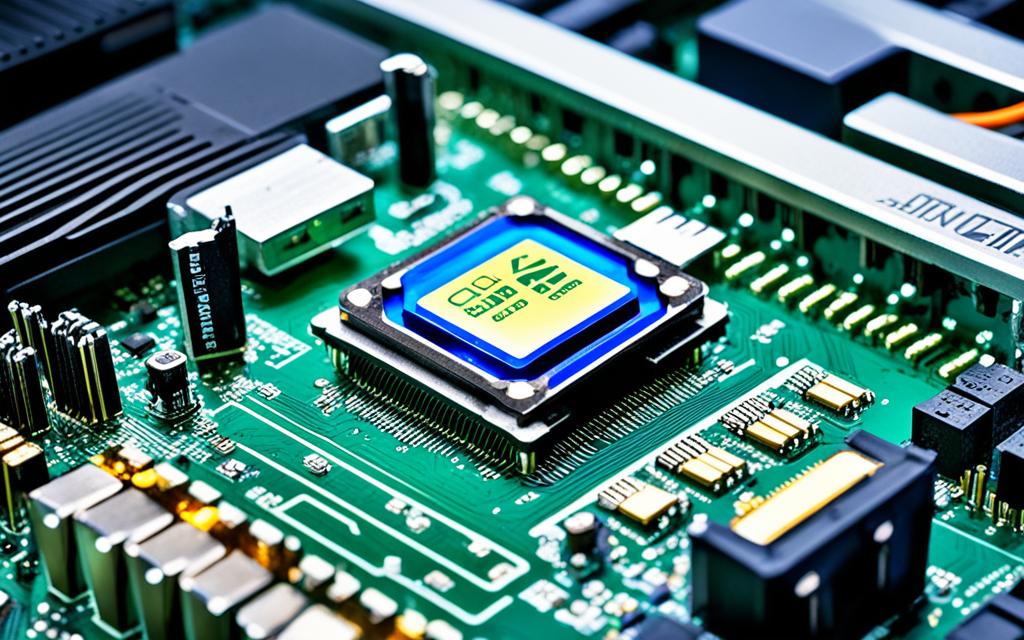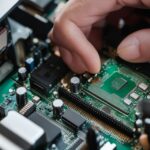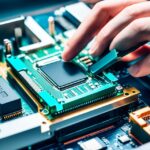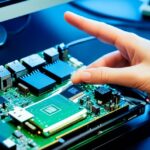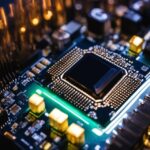Table of Contents
Flashing the BIOS with the CPU installed often sparks debates among computer lovers. It highlights crucial points about motherboard compatibility and update risks. BIOS updates aim to boost performance and add new hardware support. But, they must be done right to avoid causing system problems. Knowing when it’s okay to flash BIOS with the CPU in place can improve your computer’s work and keep it running smoothly.
We’ll dive deep into this matter, focusing on correct methods and updating benefits. Also, we’ll discuss concerns around BIOS flashback technology. So, finding out if flashing the BIOS with the CPU installed is a good idea opens a door to both chances and warnings1.
Key Takeaways
- Flashing the BIOS can enhance system performance, especially with newer hardware compatibility.
- Understanding motherboard compatibility is critical to successful BIOS updates.
- The risks associated with BIOS updates underline the need for meticulous preparation.
- Modern motherboards may include BIOS Flashback technology to ease the update process.
- Always follow manufacturer instructions to avoid unintended complications during updates.
- Pre-update checks can save time and prevent potential system issues.
Understanding the BIOS and Its Importance
The Basic Input/Output System (BIOS) is crucial in every computer. It deeply affects BIOS functionality and how well the computer performs. It checks hardware and starts the operating system, making sure your device begins smoothly. Knowing how vital BIOS is matters to anyone wanting to boost computer system performance.
The Role of BIOS in Computer Functionality
BIOS acts as a link between the computer’s hardware and software. It controls how information moves between the operating system and devices, boosting a computer’s efficiency. As gadgets advance, BIOS updates make them work with new parts, enhancing compatibility.
Why Update Your BIOS? Benefits and Risks
Updating BIOS has many benefits. It supports new processors, works with bigger storage, and fixes errors to better system function and performance2. Yet, updating BIOS comes with risks. A power cut during an update might break your computer, causing major problems2. Also, old BIOS struggles with drives over 2.1 TB. This is where UEFI is better, supporting bigger drives more effectively3.
It’s crucial for power users to think about when to update. They should weigh the benefits and risks2. Matching your system’s needs with what the latest BIOS offers helps make a good choice for your computer use.
The Process of Flashing BIOS
Flashing the BIOS is key to upgrading your computer’s power and making it work with new hardware. It rewrites the current firmware, which is vital when fitting modern CPUs into older motherboards. The BIOS upgrade process can boost your computer’s performance. However, it must be done with caution. There are different flashing methods, each with its own benefits and drawbacks.
What Does Flashing BIOS Involve?
The flashing process starts by downloading the right firmware update from the motherboard’s website. It’s important to grab the correct version. A wrong BIOS file might brick your motherboard4. After getting the update, it can be installed using software tools or directly with USB drives. Using Windows software for this job might bring more errors4, making some cautious of this approach.
Methods for Flashing BIOS
Common flashing methods include:
- EZ Flash: A built-in tool that lets users pick the BIOS file right from the motherboard.
- EZ Update: An easy way to update the BIOS from within Windows.
- USB BIOS FlashBack: Perfect for those updating the BIOS without starting the system, especially when changing old CPUs5.
These flashing methods have their own advantages, depending on what you need. Knowing which method to use can make your firmware updates more effective. For a guide on how to flash your BIOS safely, see this resource.
| Flashing Method | Suitability | Risks |
|---|---|---|
| EZ Flash | Best for direct updates via BIOS | Potential for settings to be wiped |
| EZ Update | Convenient for Windows users | Higher error probability |
| USB BIOS FlashBack | Ideal for CPU upgrades | Possible issues with USB formatting or power supply |
In summary, choosing the correct flashing method is vital to avoid problems and ensure your computer runs smoothly after a BIOS update. Be sure about each method’s requirements. Remember, it’s crucial to back up your data before any updates46.
Can You Flash BIOS with CPU Installed?
Flashing the BIOS with a CPU installed requires careful thought. Some motherboards support this, but there are technical limits. If the CPU matches the new BIOS version, the update usually goes smoothly. This can lead to better performance or more hardware options.
The Technical Constraints
Flashing BIOS with the CPU in place comes with technical challenges. Most BIOS updates need a working CPU to check the flash. So, compatibility is key to avoid update issues. For example, 12th Gen Intel Motherboards need an update to work with 13th Gen CPUs. It’s crucial to check this to prevent flash failures7.
If the new BIOS doesn’t fit the current CPU, the update might stop. This can cause issues that make the system unstable.
Scenarios Where Flashing with CPU Installed is Suggested
There are times when updating with the CPU installed is wise. If the current CPU fits the new BIOS, the update can bring improvements. Also, tools that monitor system performance help keep things steady during overclocking before and after the update.
For motherboards with a Flash BIOS Button, updating without the CPU can be easier. It lessens the stress on the system. Yet, always back up data and follow the manufacturer’s instructions closely to dodge problems8.
Exploring BIOS Flashback Technology
BIOS Flashback is a game-changer in motherboard updates, especially for system upgraders. It lets you update your BIOS without having to take out the CPU or other important parts. This means more safety and flexibility for you.
What is BIOS Flashback?
BIOS Flashback is a lifesaver for those struggling with compatibility issues. It enables easy BIOS updates without needing a working CPU, RAM, or graphics card. This is crucial for fixing failed BIOS updates or fitting new hardware.
It turns a difficult job into an easy one, making system upkeep smoother9.
Advantages of Using BIOS Flashback
The main perks of using BIOS Flashback are:
- Time Efficiency: You don’t have to dismantle your system just to update the BIOS.
- Risk Reduction: It lowers the chance of hurting your parts when you don’t have to remove the CPU or memory. This could prevent accidents9.
- Enhanced Compatibility: It makes sure you can get your motherboard ready for new CPUs better, enhancing your upgrade process9.
- Backup Solution: It offers a secure way to go back to an older BIOS if the update fails, protecting your motherboard9.
- User-Friendly Process: The steps are easy. Just download the latest BIOS to a FAT32 USB drive and hit the Flashback button9.
This feature doesn’t just make BIOS updates simpler. It also boosts safety, positioning BIOS Flashback as a key upgrade for modern motherboards. With it, you can tackle BIOS updates confidently with less trouble.
Steps to Safely Flash BIOS
Flashing your BIOS might sound tricky, but it’s quite doable with the right approach. The key to a smooth update is good preparation. Make sure you’ve got the latest BIOS update file that matches your motherboard. It has to be compressed before you start10. Choosing a trusted method, like Q-Flash, helps in safe BIOS flashing.
Pre-Update Preparations and Considerations
Before updating your BIOS, follow these tips for a smooth process. First, format your USB or hard drive to FAT32, FAT16, or FAT12. Q-Flash only works with these10. Also, ensure there won’t be any power cuts. For Dell PCs made after 2012, use the F12 menu to find the BIOS Flash Update. Make sure your battery is at least 10% full11.
Troubleshooting Common Issues During the BIOS Update
Sometimes, issues can pop up even if you’re careful. If the BIOS version doesn’t look right, double-check the update file before starting10. Don’t remove the USB or hard drive while updating to avoid any mishaps. If problems arise, restart your computer. This might let you try again once you verify the update file.
Once the BIOS update finishes, go into BIOS Setup. Load the optimized settings, save them, and then quit the BIOS Setup. Now you can restart your machine with updated BIOS settings10.
Conclusion
In conclusion, updating the BIOS with the CPU in place depends on things like motherboard design and BIOS version. BIOS Flashback allows for BIOS updates without a CPU, making upgrades easier121314. Modern motherboards from trusted brands often have this feature, providing reliable upgrade options12.
Flashing the BIOS with the CPU can improve system compatibility and stability. It’s vital to prepare correctly before starting. Understanding the advantages and limits of these technologies helps ensure successful upgrades1213.
Having the right knowledge, a compatible motherboard, and a good plan are key for managing BIOS well.
Whether you’re using BIOS Flashback or traditional update methods, knowing what’s needed and following manufacturer advice helps avoid issues. This way, you maintain high system performance and reliability1214.
FAQ
Is it safe to flash the BIOS with the CPU installed?
Yes, it can be safe to flash the BIOS with the CPU in place. But, this depends on your motherboard and BIOS version being compatible. Make sure the new BIOS supports your current CPU before you start.
What preparations should I take before flashing the BIOS?
Before flashing the BIOS, back up your current settings. Also, download the right BIOS file for your motherboard. Make sure it matches your hardware to avoid any problems.
What are the risks associated with a BIOS update?
A BIOS update can cause issues like hardware not working well together. If the update stops suddenly, your system might fail. Using the wrong BIOS file could also make your system unstable.
Can I use BIOS Flashback to update my BIOS without a CPU?
Yes, if your motherboard has BIOS Flashback, you can update it without a CPU, RAM, or graphics card. This feature is handy if you’re fixing compatibility issues or recovering from an update that didn’t work.
How do I troubleshoot problems during the BIOS flashing process?
If you run into issues, check you’re using the right BIOS version. Make sure everything is unplugged if there’s an interruption. Also, check that your components are installed correctly before updating.
Why is it important to update the BIOS?
A BIOS update is important for a few reasons. It helps with system compatibility and performance. It also delivers bug fixes that solve problems with hardware or software on your computer.
Source Links
- https://softwareg.com.au/blogs/computer-hardware/can-you-use-bios-flashback-with-cpu-installed – Can You Use Bios Flashback With CPU Installed
- http://blog.superuser.com/2011/04/03/what-is-flashing-the-bios/ – What is “Flashing the BIOS”? « Super User Blog
- https://www.simplilearn.com/what-is-bios-article – What is BIOS? A Guide for Beginners | Simplilearn
- https://www.tomshardware.com/how-to/update-bios-on-a-pc – How to Update the BIOS on a PC: 3 Ways to Get New Firmware
- https://www.asus.com/us/support/faq/1044348/ – [Motherboard] How to update BIOS of the motherboard ?(Include different generation CPU) | Official Support | ASUS USA
- https://www.partitionwizard.com/partitionmagic/bios-flashback.html – How to Use BIOS FlashBack [ASUS, MSI, Gigabyte, ASRock Boards] – MiniTool Partition Wizard
- https://www.easeus.com/backup-recovery/how-to-update-bios-without-cpu.html – In-depth Guide | How to Update BIOS Without CPU🔥
- https://www.linkedin.com/advice/1/how-do-you-update-your-bios-without-cpu-skills-pc-building – How do you update your BIOS without a CPU?
- https://softwareg.com.au/blogs/computer-hardware/asus-bios-flashback-with-cpu-installed – Asus Bios Flashback With CPU Installed
- https://www.gigabyte.com/FileUpload/Global/WebPage/20/images/utiltiy_qflash_uefi.pdf – PDF
- https://www.dell.com/support/kbdoc/en-us/000128928/flashing-the-bios-from-the-f12-one-time-boot-menu – Flashing the BIOS from the F12 One-Time Boot Menu
- https://ms.codes/blogs/computer-hardware/can-you-use-bios-flashback-with-cpu-installed – Can You Use Bios Flashback With CPU Installed
- https://softwareg.com.au/blogs/computer-hardware/can-you-q-flash-with-cpu-installed – Can You Q Flash With CPU Installed
- https://ms.codes/en-gb/blogs/computer-hardware/asus-bios-flashback-with-cpu-installed – Asus Bios Flashback With CPU Installed

